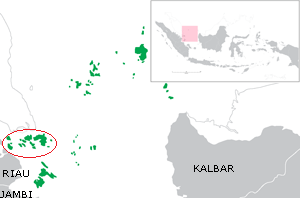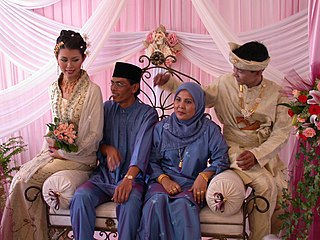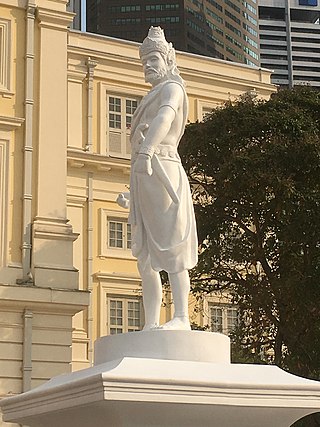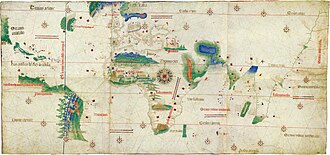
Temasek is an early recorded name of a settlement on the site of modern Singapore. The name appears in early Malay and Javanese literature, and it is also recorded in Yuan and Ming Chinese documents as Danmaxi. Two distinct settlements were recorded in Temasek – Long Ya Men and Ban Zu. The name is used in modern-day Singapore for national honours as well as institutions and corporations.

The Riau Archipelago is a geographic term for the core group of islands within the Riau Islands Province in Indonesia, and located south of Singapore and east of Riau on Sumatra. Before the province of Riau Islands was formed, there was no ambiguity in term; however, in Indonesian language, both the archipelago and administrative province are referred to simply as "Kepulauan Riau". The province may have the word "Provinsi" preceding it for clarity. Additionally, the term BBK for Batam Bintan Karimun may refer to the archipelago.

Malay Singaporeans are Singaporeans of Malay ancestry, including those from the Malay Archipelago. They constitute approximately 13.5% of the country's citizens, making them the second largest ethnic group in Singapore. Under the Constitution of Singapore, they are recognised by the government as the indigenous people of the country, with Malay as the national language of Singapore.
Telok Blangah is a subzone region and housing estate located in the area behind Keppel Harbour in Bukit Merah, Singapore. Teluk Blanga is the district between Pasir Panjang and Tanjong Pagar.

The establishment of a British trading post in Singapore in 1819 by Sir Stamford Raffles led to its founding as a British colony in 1824. This event has generally been understood to mark the founding of colonial Singapore, a break from its status as a port in ancient times during the Srivijaya and Majapahit eras, and later, as part of the Sultanate of Malacca and the Johor Sultanate.

Fort Canning Hill, formerly Government Hill, Singapore Hill and Bukit Larangan, or simply known as Fort Canning, is a prominent hill, about 48 metres (157 ft) high, in the southeast portion of Singapore, within the Central Area that forms Singapore's central business district.

Sang Nila Utama was a prince from Palembang and is the founder of the Kingdom of Singapura in 1299. His official title adopted upon his coronation was Sri Tri Buana, which can be translated as "Lord of Three Worlds"; the "Three Worlds" may refer to the three realms of the universe—the heaven of the gods, the world of humans, and the underworld of demons or his lordship over Java, Sumatra and Temasek/Singapura. This title is attested to elsewhere in Southeast Asia.

The history of the modern state of Singapore dates back to its founding in the early 19th century; however, evidence suggests that a significant trading settlement existed on the island in the 14th century. The last ruler of the Kingdom of Singapura, Parameswara, was expelled by the Majapahit or the Siamese before he founded Malacca. Singapore then came under the Malacca Sultanate and subsequently the Johor Sultanate. In 1819, British statesman Stamford Raffles negotiated a treaty whereby Johor would allow the British to locate a trading port on the island, ultimately leading to the establishment of the Crown colony of Singapore in 1867. Important reasons for the rise of Singapore were its nodal position at the tip of the Malay Peninsula flanked by the Pacific and Indian Oceans, the presence of a natural sheltered harbour, as well as its status as a free port.

The early history of Singapore refers to its pre-colonial era before 1819, when the British East India Company led by Stamford Raffles established a trading settlement on the island and set in motion the history of modern Singapore.

Singapore Island, or Pulau Ujong, is the main constituent island of the sovereign island country and city-state of the Republic of Singapore. It is located at the southern tip of Malay Peninsula, in-between the Straits of Malacca and the South China Sea. The Singapore Strait lies to the south, while the Johor Strait lies to the north.

The coat of arms of Singapore is the heraldic symbol representing the sovereign island country and city-state of Singapore located in maritime Southeast Asia. It was adopted in 1959, the year Singapore attained self-governance from the British Empire, and remains in use after its independence in 1965. The committee that created it, headed by Toh Chin Chye, who was also responsible for the national flag and the national anthem of Singapore.

According to the Malay Annals, Paduka Sri Wikrama Wira or Sri Pikrama Wira ('Vikramavira') was the eldest son of Sang Nila Utama and the second Raja of Singapura. He was known as Raja Kecil Besar before his accession and married to an Indian princess named Nila Panjadi. His reign was from 1347 to 1362.

Parameswara, thought to be the same person named in the Malay Annals as Iskandar Shah, was the last king of Singapura and the founder of Malacca. According to the Malay Annals, he ruled Singapura from 1389 to 1398. The king fled the island kingdom after a Majapahit naval invasion in 1398 and founded his new stronghold on the mouth of Bertam river in 1402. Within decades, the new city grew rapidly to become the capital of the Malacca Sultanate. Portuguese accounts however, written a hundred years after his death, suggest he was from Palembang in Sumatra and usurped the throne of Singapura; he was driven out, either by the Siamese or the Majapahit, and went on to found Malacca.

The Kingdom of Singapura was a Malay Hindu-Buddhist kingdom thought to have been established during the early history of Singapore upon its main island Temasek from 1299 until its fall sometime between 1396 and 1398. Conventional view marks c. 1299 as the founding year of the kingdom by Sang Nila Utama, whose father is Sang Sapurba, a semi-divine figure who according to legend is the ancestor of several Malay monarchs in the Malay World.
Sri Maharaja Sang Sapurba Paduka Sri Trimurti Tri Buana, (1245–1316) also known as Sri Nila Pahlawan, is a figure in the Malay Annals, highly revered as the legendary great ancestor of some of the major dynasties of the Malay world: Singapura, Malacca, Pahang, Johor, Perak, Kelantan, Terengganu and Siak Sri Indrapura. Legend has it that after his accession to Seguntang Hill with his two younger brothers, Sang Sapurba enters into a sacred covenant with Demang Lebar Daun the native ruler of Palembang, which laid the basis of the proper relationship between the Malay rulers and the subjects. The legendary sword believed to be carried by the king, the Cura Si Manjakini, is now formed part of the regalia of Perak Sultanate, whose rulers are said directly descended from the king. The details of Sang Sapurba stories are mainly composed of folklore and legends, and thus his historical existence is debated and disputed by modern historians. Even so, as De Jong argued in her article The Character of Malay Annals, the stories of the Malay Annals could have been realistically mixed with the historical figures and events.

Cura Si Manjakini is a sword mentioned in the Malay Annals as originally possessed by Sang Sapurba, the legendary ancestor of Malay kings. For hundreds of years, the sword became a symbol of a rightful sovereignty and power in Malay culture. It was first inherited by Sang Nila Utama the founder of Singapura, later by Parameswara the first ruler of Melaka Sultanate, and then by Muzaffar Syah I the first Sultan of Perak. The sword is now a part of the Perak Sultanate's official regalia.

Southeast Asia was in the Indian sphere of cultural influence from 290 BCE to the 15th century CE, when Hindu-Buddhist influences were incorporated into local political systems. Kingdoms in the southeast coast of the Indian subcontinent had established trade, cultural and political relations with Southeast Asian kingdoms in Burma, Bhutan, Thailand, the Sunda Islands, Malay Peninsula, Philippines, Cambodia, Laos, and Champa. This led to the Indianisation and Sanskritisation of Southeast Asia within the Indosphere, Southeast Asian polities were the Indianised Hindu-Buddhist Mandala.

Old Pahang Kingdom was a historical Malay polity centred in the Pahang region in the east coast of Malay Peninsula. The polity appeared in foreign records from as early as the 5th century and at its height, covered much of modern state of Pahang and the entire southerly part of the peninsula. Throughout its pre-Melakan history, Pahang was established as a mueang or naksat of some major regional Malayic mandalas including Langkasuka, Srivijaya and Ligor. Around the middle of the 15th century, it was brought into the orbit of Melaka Sultanate and subsequently established as a vassal Muslim Sultanate in 1470, following the coronation of the grandson of the former Maharaja as the first Sultan of Pahang.

Ban Zu or Banzu was a port settlement believed to have thrived in Singapore during the 14th century. It is thought to be located on Fort Canning Hill and the area on the north bank of the Singapore River basin between the hill and the sea. It was mentioned by the Chinese traveller Wang Dayuan in his work Daoyi Zhilüe together with Long Ya Men as the two settlements that made up Temasek. It may have been abandoned before 1400 after an attack by either the Siamese or the Majapahit.

The visual art of Singapore, or Singaporean art, refers to all forms of visual art in or associated with Singapore throughout its history and towards the present-day. The history of Singaporean art includes the indigenous artistic traditions of the Malay Archipelago and the diverse visual practices of itinerant artists and migrants from China, the Indian subcontinent, and Europe.



















